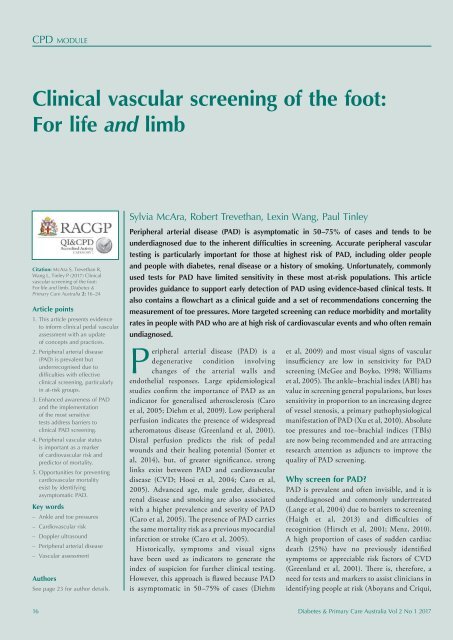DPCA2-1
You also want an ePaper? Increase the reach of your titles
YUMPU automatically turns print PDFs into web optimized ePapers that Google loves.
CPD module<br />
Clinical vascular screening of the foot:<br />
For life and limb<br />
Sylvia McAra, Robert Trevethan, Lexin Wang, Paul Tinley<br />
Citation: McAra S, Trevethan R,<br />
Wang L, Tinley P (2017) Clinical<br />
vascular screening of the foot:<br />
For life and limb. Diabetes &<br />
Primary Care Australia 2: 16–24<br />
Article points<br />
1. This article presents evidence<br />
to inform clinical pedal vascular<br />
assessment with an update<br />
of concepts and practices.<br />
2. Peripheral arterial disease<br />
(PAD) is prevalent but<br />
underrecognised due to<br />
difficulties with effective<br />
clinical screening, particularly<br />
in at-risk groups.<br />
3. Enhanced awareness of PAD<br />
and the implementation<br />
of the most sensitive<br />
tests address barriers to<br />
clinical PAD screening.<br />
4. Peripheral vascular status<br />
is important as a marker<br />
of cardiovascular risk and<br />
predictor of mortality.<br />
5. Opportunities for preventing<br />
cardiovascular mortality<br />
exist by identifying<br />
asymptomatic PAD.<br />
Key words<br />
– Ankle and toe pressures<br />
– Cardiovascular risk<br />
– Doppler ultrasound<br />
– Peripheral arterial disease<br />
– Vascular assessment<br />
Authors<br />
See page 23 for author details.<br />
Peripheral arterial disease (PAD) is asymptomatic in 50–75% of cases and tends to be<br />
underdiagnosed due to the inherent difficulties in screening. Accurate peripheral vascular<br />
testing is particularly important for those at highest risk of PAD, including older people<br />
and people with diabetes, renal disease or a history of smoking. Unfortunately, commonly<br />
used tests for PAD have limited sensitivity in these most at-risk populations. This article<br />
provides guidance to support early detection of PAD using evidence-based clinical tests. It<br />
also contains a flowchart as a clinical guide and a set of recommendations concerning the<br />
measurement of toe pressures. More targeted screening can reduce morbidity and mortality<br />
rates in people with PAD who are at high risk of cardiovascular events and who often remain<br />
undiagnosed.<br />
Peripheral arterial disease (PAD) is a<br />
degenerative condition involving<br />
changes of the arterial walls and<br />
endothelial responses. Large epidemiological<br />
studies confirm the importance of PAD as an<br />
indicator for generalised atherosclerosis (Caro<br />
et al, 2005; Diehm et al, 2009). Low peripheral<br />
perfusion indicates the presence of widespread<br />
atheromatous disease (Greenland et al, 2001).<br />
Distal perfusion predicts the risk of pedal<br />
wounds and their healing potential (Sonter et<br />
al, 2014), but, of greater significance, strong<br />
links exist between PAD and cardiovascular<br />
disease (CVD; Hooi et al, 2004; Caro et al,<br />
2005). Advanced age, male gender, diabetes,<br />
renal disease and smoking are also associated<br />
with a higher prevalence and severity of PAD<br />
(Caro et al, 2005). The presence of PAD carries<br />
the same mortality risk as a previous myocardial<br />
infarction or stroke (Caro et al, 2005).<br />
Historically, symptoms and visual signs<br />
have been used as indicators to generate the<br />
index of suspicion for further clinical testing.<br />
However, this approach is flawed because PAD<br />
is asymptomatic in 50–75% of cases (Diehm<br />
et al, 2009) and most visual signs of vascular<br />
insufficiency are low in sensitivity for PAD<br />
screening (McGee and Boyko, 1998; Williams<br />
et al, 2005). The ankle–brachial index (ABI) has<br />
value in screening general populations, but loses<br />
sensitivity in proportion to an increasing degree<br />
of vessel stenosis, a primary pathophysiological<br />
manifestation of PAD (Xu et al, 2010). Absolute<br />
toe pressures and toe–brachial indices (TBIs)<br />
are now being recommended and are attracting<br />
research attention as adjuncts to improve the<br />
quality of PAD screening.<br />
Why screen for PAD?<br />
PAD is prevalent and often invisible, and it is<br />
underdiagnosed and commonly undertreated<br />
(Lange et al, 2004) due to barriers to screening<br />
(Haigh et al, 2013) and difficulties of<br />
recognition (Hirsch et al, 2001; Menz, 2010).<br />
A high proportion of cases of sudden cardiac<br />
death (25%) have no previously identified<br />
symptoms or appreciable risk factors of CVD<br />
(Greenland et al, 2001). There is, therefore, a<br />
need for tests and markers to assist clinicians in<br />
identifying people at risk (Aboyans and Criqui,<br />
16 Diabetes & Primary Care Australia Vol 2 No 1 2017
















